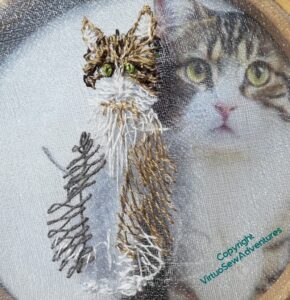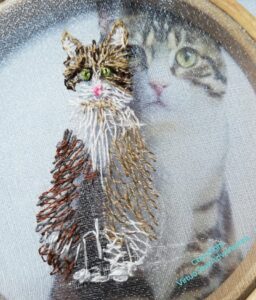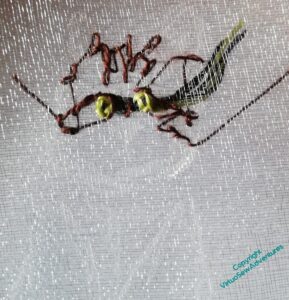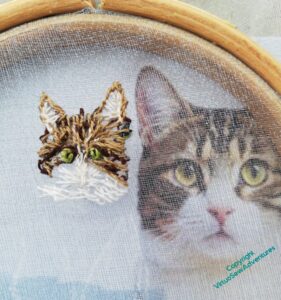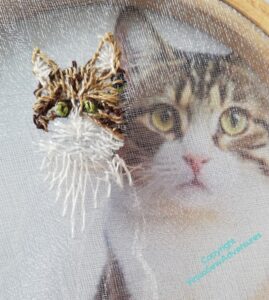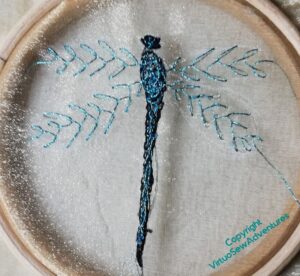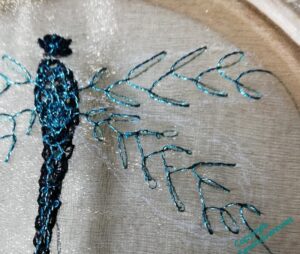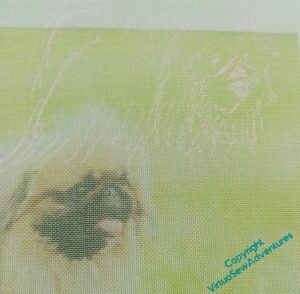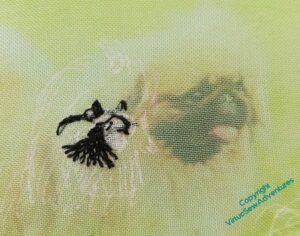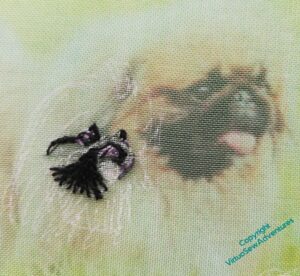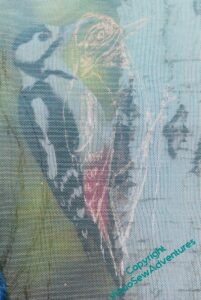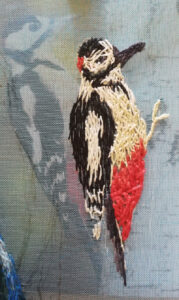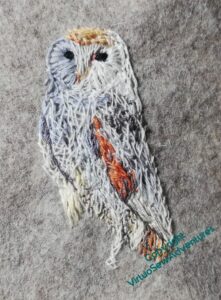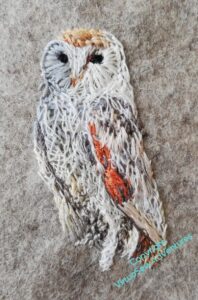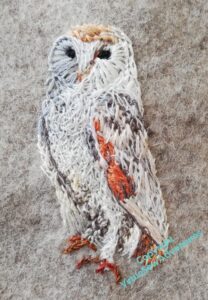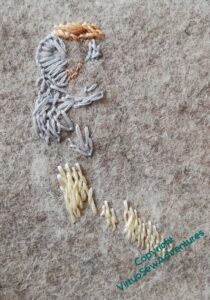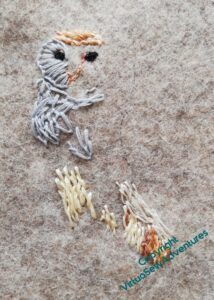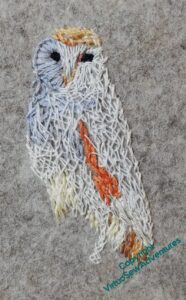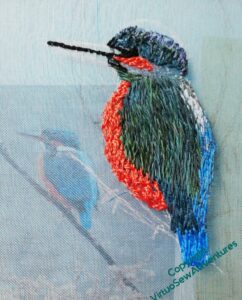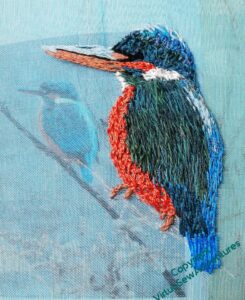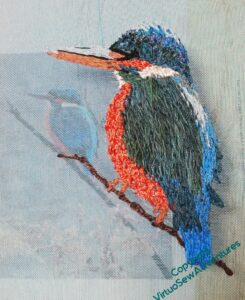Tag: Vision of Placidus
More on the cat, Smith
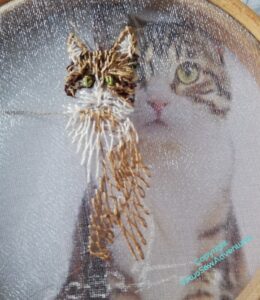
The Cat Smith, like all cats, has Standards. Whether I’ll attain comparable standards is still not certain!
I think the head is pretty much done, at least until final balancing, so now I have to move on to the body. This is the blocking-in stage, so I’m starting by looking at my image source. This particular cat looks lighter on the right hand side than the left, so I’m starting with a sort of underlayer of cretan stitches across the body.
Light fawn on the right, here, and grey on the left. What I am hoping is that after a couple of suitably tangled layers of cretan stitch, as I do the smaller markings, there will be a nicely furry effect. It’s really useful that I can see the cat through the gauze while I’m planning this!
I now realise, however, that I’ve forgotten to do poor Smith’s tail!
I also think that his white shirtfront isn’t quite big enough, but that gives me a chance to blur the edges a bit more, which will help with the furriness.
And I think the eyes need to be bigger, and maybe lighter. But, you know, the more I study my sources, the more it becomes possible to see what I need to do next.
Starting The Cat, Smith
There is, among the dramatis animalae (my thanks to Anne Louise Avery for coming up with the term!) of “The Herb of Grace”, a tabby of imposing mien, introduced by his staff as “The cat, Smith”. In my memory he gets the whole name and title in full on all occasions, so I decided to include a tabby cat looking gravely out at the viewer.
Working on gauze produces alarming effects, early on. I started with the eyes, this time. I can tweak them later, but I felt that if I had them in place it might make placement of everything else easier.
I might even be right. I think I’ve set the eyes too close, and maybe not made the ears broad enough, but he is gradually taking shape.
Everything about these animal vignettes is an exercise in learning to see, and discovering how much more there is to see on each pass. As I write this, some weeks after beginning to stitch The Cat, Smith, I find myself comparing my stitching with my source photo and spotting things I missed, or maybe mishandled, and wondering how much tweaking that gauze will take.
I don’t think the head is finished, but I felt it was time to move on to the body, all the same. I’m going to try to block everything in and then refine later, so here I’m starting with his shirt front, and as I continue I will pick what seems like either the predominant colour or the background colour, whichever seems easier, and work that.
Each layer worked into that layer will help to create colours and shadows and, I hope, the sense of air in the fur.
Dragonfly – first trial..
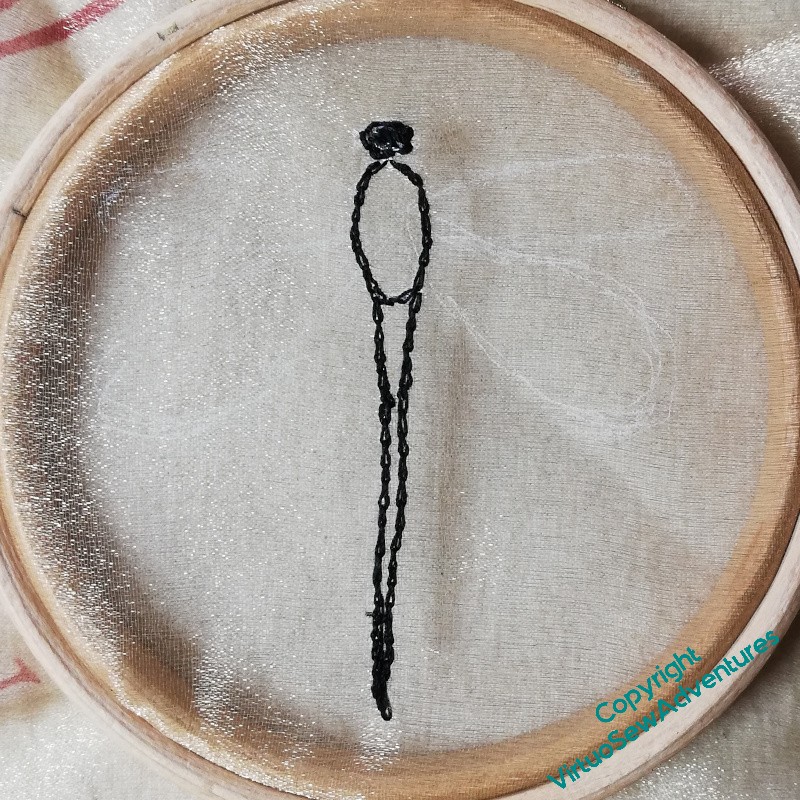
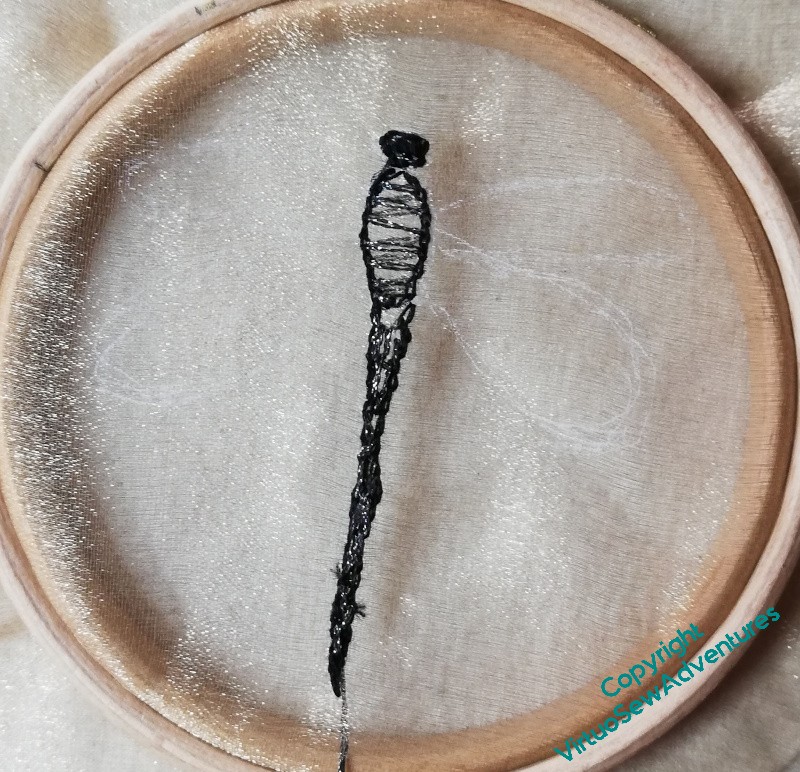

I find dragonflies and damselflies absolutely enchanting. I’m not entirely sure that I’ve got the right sense of delicacy and enchantment here – the threads are a little clunky, maybe, and the metallic thread wants a conditioner or something else to protect it as I work. I wanted to use a longish thread so that I didn’t have lots of tyings-off, but that just meant more opportunity for tangles.
I outlined the body and then worked straight stitches across in a dark metallic thread. The intention was to work needlelace type stitches in the coloured thread, catching into the dark straight stitches. The idea was that that would modify the colour slightly.
It has worked after a fashion, and the feather stitch veins on the wings also work after a fashion. But not quite.
I need to think of ways to finish off the veins in the wings so the stitches don’t unravel – glue? fraycheck? enclosure?
And I think I maybe need to do it again, smaller, and using a single strand.
Thinking aloud about Placidus..
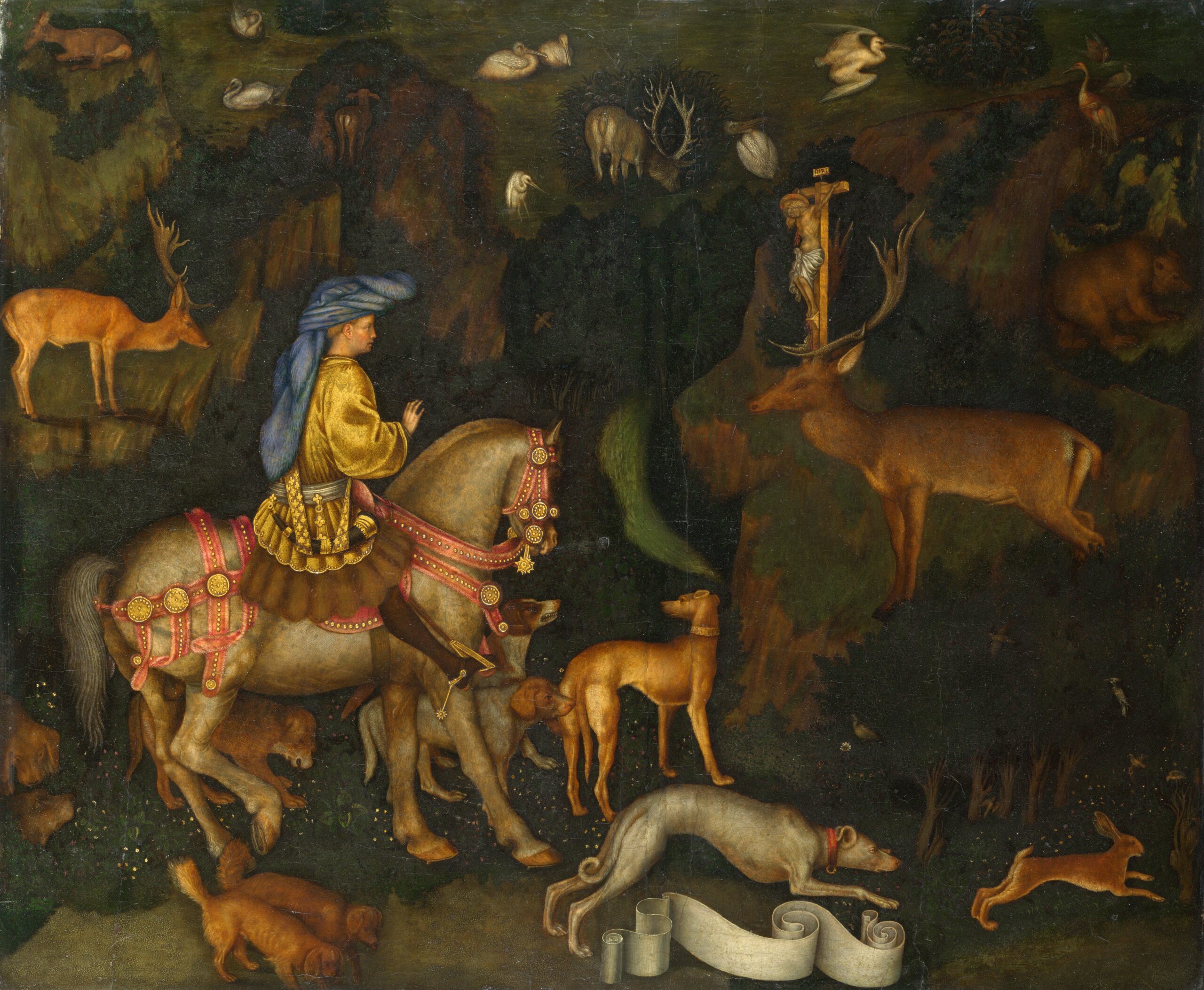
This images is from “Pisanello – The Yorck Project (2002) 10.000 Meisterwerke der Malerei (DVD-ROM), distributed by DIRECTMEDIA Publishing GmbH. ISBN: 3936122202.”
If you really look at this painting, it has a rather otherworldly quality. The animals and the figure of St Eustace (he changed his name when he converted) all seem rather stiff and the landscape makes very little sense. It almost looks as though the figures are painted on top of a map of the forest, rather than being part of a scene.
I suppose when you consider that it is a painting representing an encounter with the numinous, it needn’t make sense. And perhaps he is depicting the moment after the event, when everything winds back a little.
I want to depict, if I can, the moment itself. The pulse of – Something – from the stag, the dogs and the horse and the man all astonished, skidding to a stop from a headlong chase. But also – and my little Animal Vignettes should help with this – the sense that this is happening in a forest with other creatures going about their daily activities. Some will be observing, aware; some, like the little Fawn, totally oblivious. My thought at the moment is for the stag to have bounded up onto a convenient bit of rock, and started a waterfall, which references the water of baptism. I’m finding it hard to design a landscape that makes sense.
Maybe Pisanello had that problem too! There’s no reason to believe the artists of the past had it any easier than we do…
Finding the right references for horses reined in from a gallop is so far proving impossible, and so many other things are proving elusive, too. I originally planned to have a frame of scrollwork with the symbols of the four Gospels in the four corner, then I thought I would extend the animals into the frame, and now I don’t know at all.
This is another case when I find myself agreeing with Degas (“If it were easy, it would not be fun!”). It is the difficulties and the challenges that give me something interesting to ponder, and devising my improvisatory stitching technique for the animals is giving me some interesting stitching.
Mary The Pekinese again
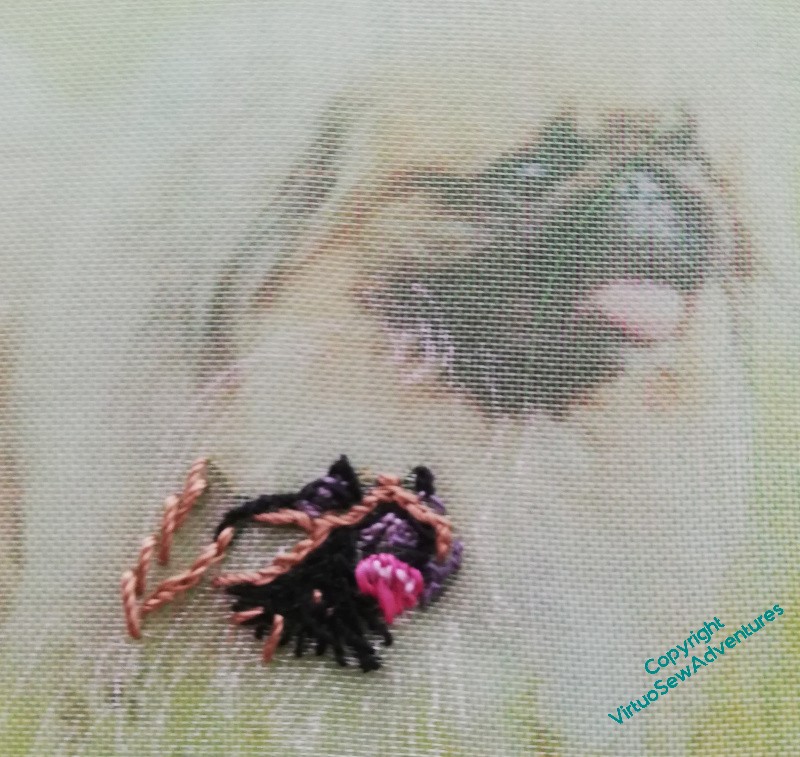
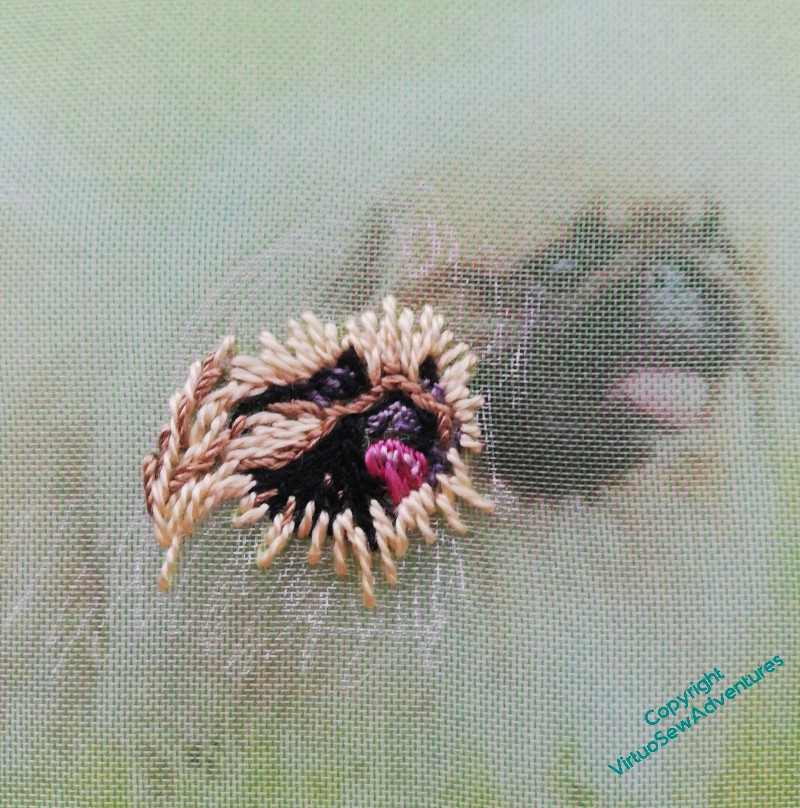
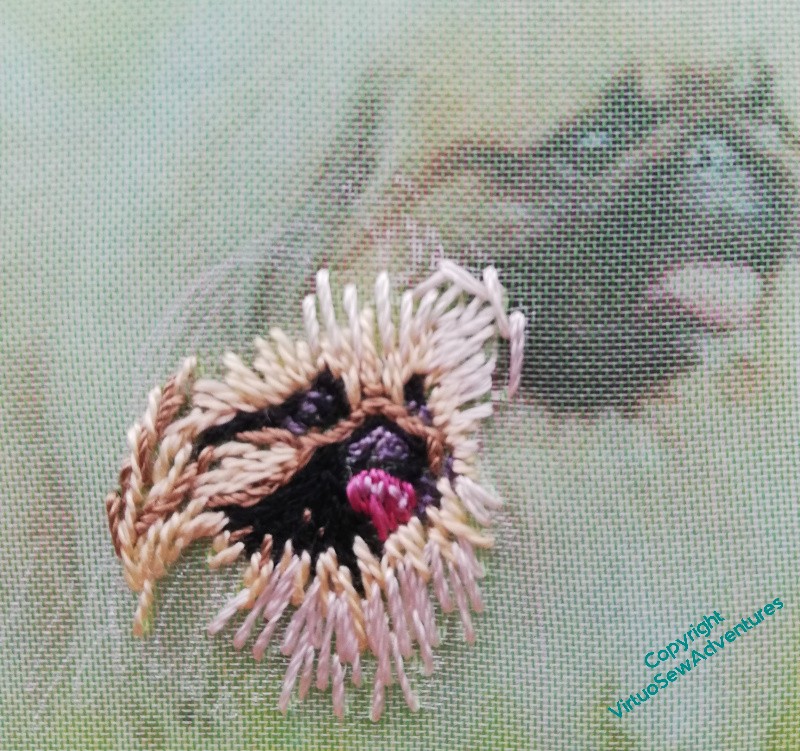
It’s quite hard to explain what I mean by the improvisatory, painterly approach I’m using for the assorted Animal Vignettes for the Conversion of Placidus project, so since Mary the Pekinese is relatively simple compared with some of the others – mostly straight stitches, rather than the tangle of Cretan I used, for example, for the little rabbit, I thought maybe a sequence of photos was the best way to show you what happens.
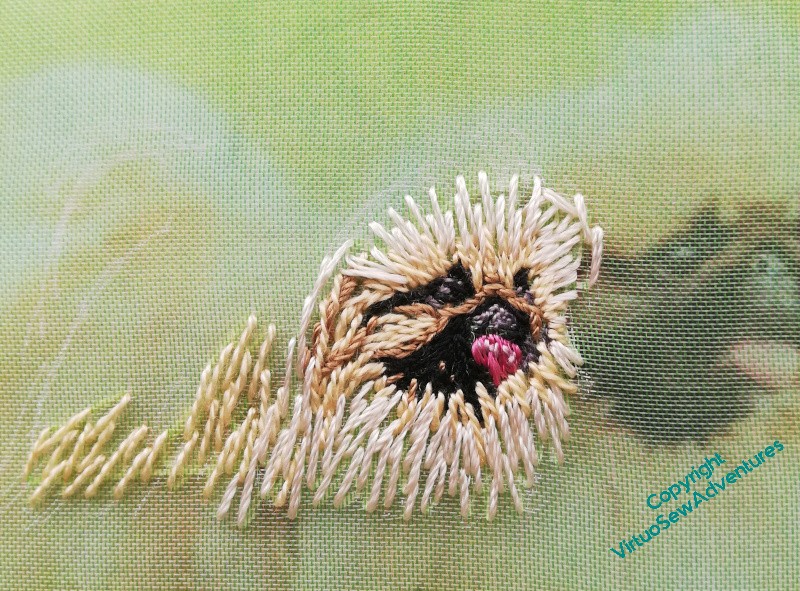
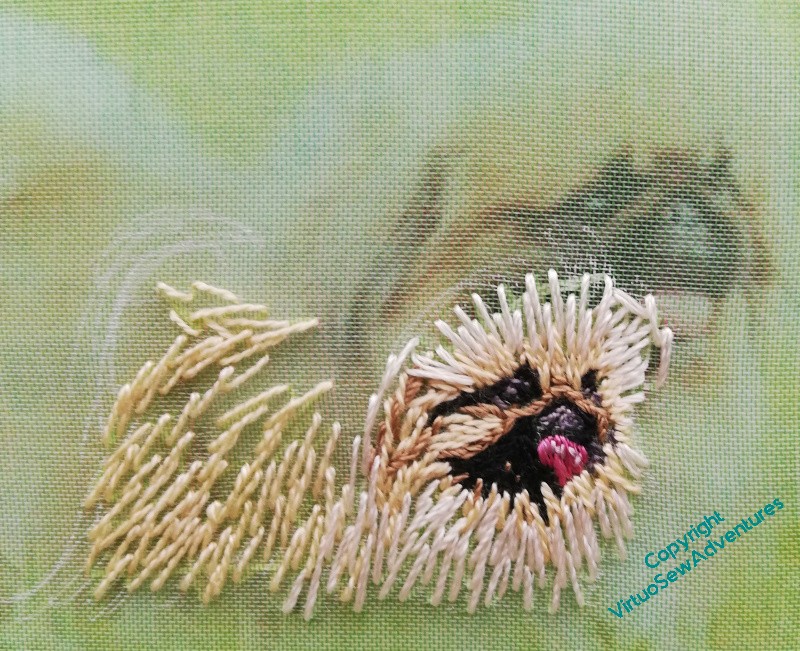
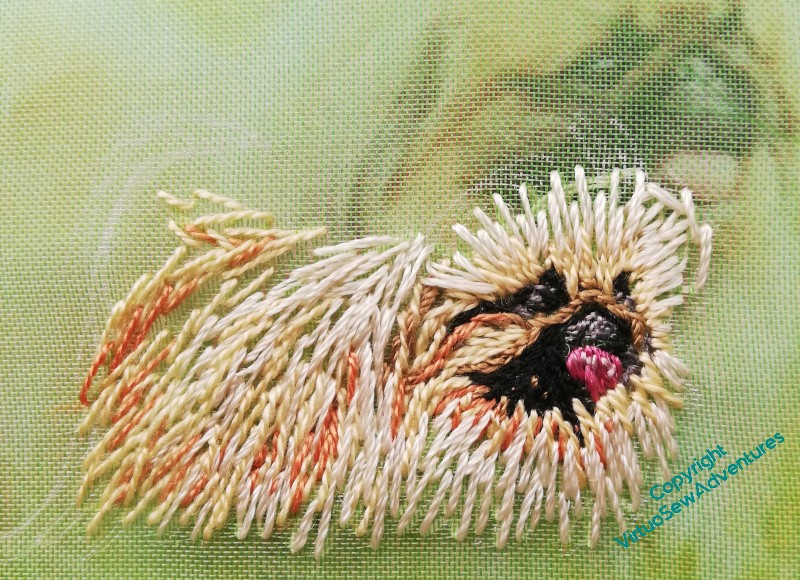
In each case I’ve put the frame on top of the photo I’m using. The finer, subtler details of the fur don’t really show through the gauze, but it does give you some sense of how I am selecting my threads to capture the impression of colour and texture that I’m working from. I’m not concerning myself at all with what fibre the thread is made from – if it does what I want it to do, I’m using it.
I’m also recollecting a quotation I found, attributed to the painter Edgar Degas : “If it were not difficult, it would not be fun!”
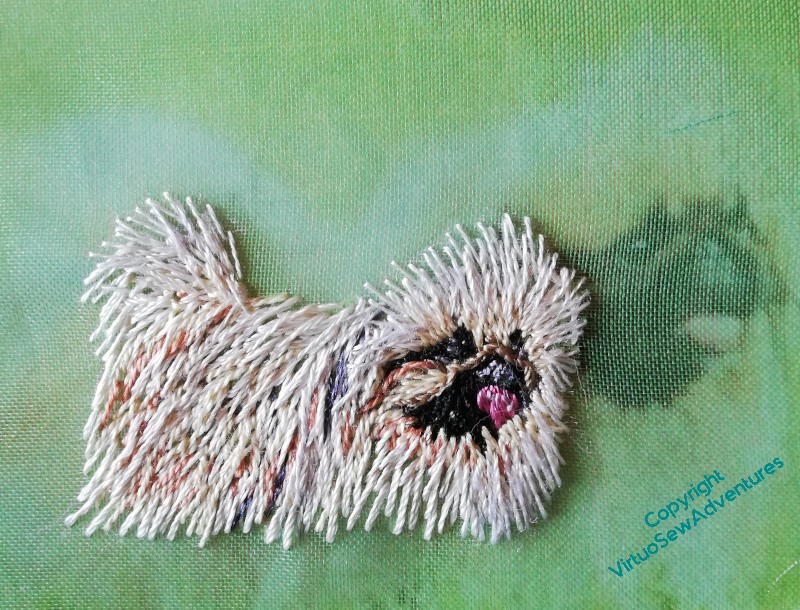
Worth the effort, though. I do think she’s turned out rather well!
Starting Mary the Pekinese
Now, although the starting impulse for the Placidus panel is the Pisanello painting (and I will be saying more about that in another post), it is also Elizabeth Goudge’s story, woven around an imagined version on an ancient wall. In the book, “The Herb of Grace”, the painting is already in the air, in your mind as you read, long before the mischievous young twins start pulling wallpaper off the pantry wall to reveal an ancient fresco.
So although I’m not intending any humans other than Placidus himself to be in the painting, the family dogs are definitely going to be in there, and I am starting with Mary the white pekinese.
And here we go again – the sketchiest of outlines, a piece of gauze, and the sort of breathless pause you take when you Definitely Don’t Want To Ruin It.
As you can see, the stitched version isn’t the same size as the source photo, so I can’t quite lay the gauze over the top to find where to stitch, but I can compare the shapes I’m creating. The black thread (good grief, I’m using black thread!!) is a fine silk, as used on the woodpecker.
The grey thread here in the highlights is from a gorgeous variegated silk eight strand thread. I think I may have bought it for “Leaving The Tyne“, but to be honest, at this stage I have no idea! It’s going to be useful, though, because I have several shades to pick from within a single length..
And I am already startled by how well Mary the Pekinese is looking.
There’s going to be a woodpecker, too..
I am going to start rereading the book again, at some point soon, but in the meantime, since I’ve rediscovered my “Vision of Placidus” notebook, I know that one of the birds I was going to include is a woodpecker.
I’m going to have to go to the shops and find some more gauze soon, as well, but while I can squeeze an animal in to the existing fabrics, I will do so.
I’ve commented before, I think, that getting a readable and workable design drawing onto gauze is a non-trivial exercise, but this opaque white line (a Posca pen) is pretty much the best I’ve found so far, and it also allows me to help myself by putting a few extra emphases on the lightest parts.
It’s amazing how quickly these little animals go, once I have a chance to get started. In fact, I was so entranced by how Woody was growing that I didn’t stop to take photos. In fact, I barely stopped to draw breath.
So this photograph shows a single afternoon’s work. I’ve used mostly fine silk threads, although his red breeches are a soft perle, and some of the white is probably cotton. As for approach – I simply tangle my stitches together, feather stitch variations, Cretan stitch variations, the occasional chain stitch or straight stitch. What I’m hoping is that the tangle of stitches will create a subtle variation in colour that will help the whole thing feel alive when it’s viewed from a reasonable distance.

I didn’t have much I wanted to add, in the end. A few highlights, filling in the wings a little, and then really the woodpecker is done. I may add more when it comes to assembling the piece (remember all those seed stitches I added to the View of the Excavation once I started assembling the Dreams of Amarna panels?), but that can wait until I know what is being balanced with what.
I have been thinking, on and off, since I was asked about it after my talk, that assembling Placidus may prove to be an exceptionally challenging process. The panel I envisage is going to be about five foot by four foot, and I have a horrible feeling I’m going to be propping it against a wall or slinging it from hooks or even emulating one or other of the great Impressionists by somehow arranging a slot in the floor to drop it into while I tackle the top.
Maybe I shouldn’t be in too much of a hurry to finish this one…!
Finishing The Kingfisher
The kingfisher has been really quite tricky, but rewarding, too.
I do enjoy these colours, for a start, and the chance to use the really glossy rayon thread that helps his bright orange breast to shine. For the bright stripe of his back and tail, I’ve ended up combining threads in the needle to get just the colour I want. Even with a full range of Madeira stranded cotton in my thread stash, the precise colour and tone weren’t quite there. There’s another variegated mercerised machine thread in the mix as well – I think the motto for this piece is going to be “Whatever It Takes!”!
When I looked closely, I realised that the lower beak and the little claws were a very similar colour. The feet have been made a little scalier by stacking single twisted chain stitches atop one another so that they narrow into claws.
I’ve made the dark line of the beak narrower by bringing split stitches close in on either side, and done a lot of staring and adding little areas – the top of his head, the white flash at the side of the head, and the tiny bit of white at the throat. When I put him wherever he ends up, that will be one of the push-pull elements that helps him to detach sufficiently from the background to do his job.
Finally, I decided that the couple of bits of dark showing the underside of the far wing did in fact need to go in – more of the push-pull.
Then he wanted a twig to sit on. When I come to set him in place, I may cut some of the fabric close or turn it under, but other parts may be left so that the blue gauze modifies whatever is underneath. Some of this twig may be undone, some of it may be enhanced and extended.
I am reminding myself that I don’t work my best when I’m fretting about the Whole Thing. I do very much better when I get started and work out the whole thing later. I need to read the book again, to see whether there are particular animals I have to include. That will be no hardship, it’s a much beloved book!
I shall be giving a talk for the Embroiderers Guild on June 3!
I believe I’ve turned this image into a link to the Eventbrite page, and for anyone not in the right timezone, or otherwise occupied on the day of the talk, the Guild makes recordings available for some time afterwards.
I shall remind you every week until it happens!

